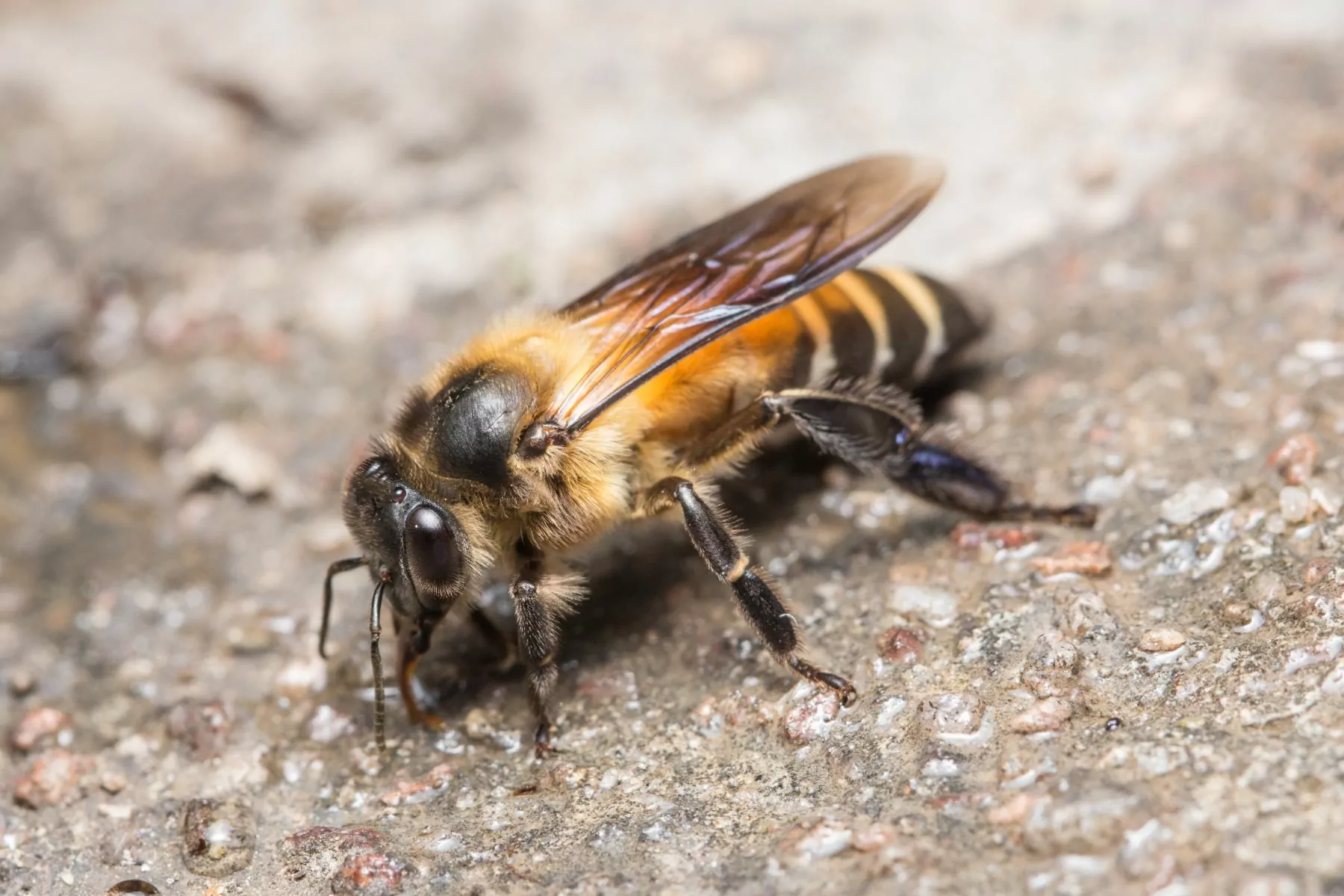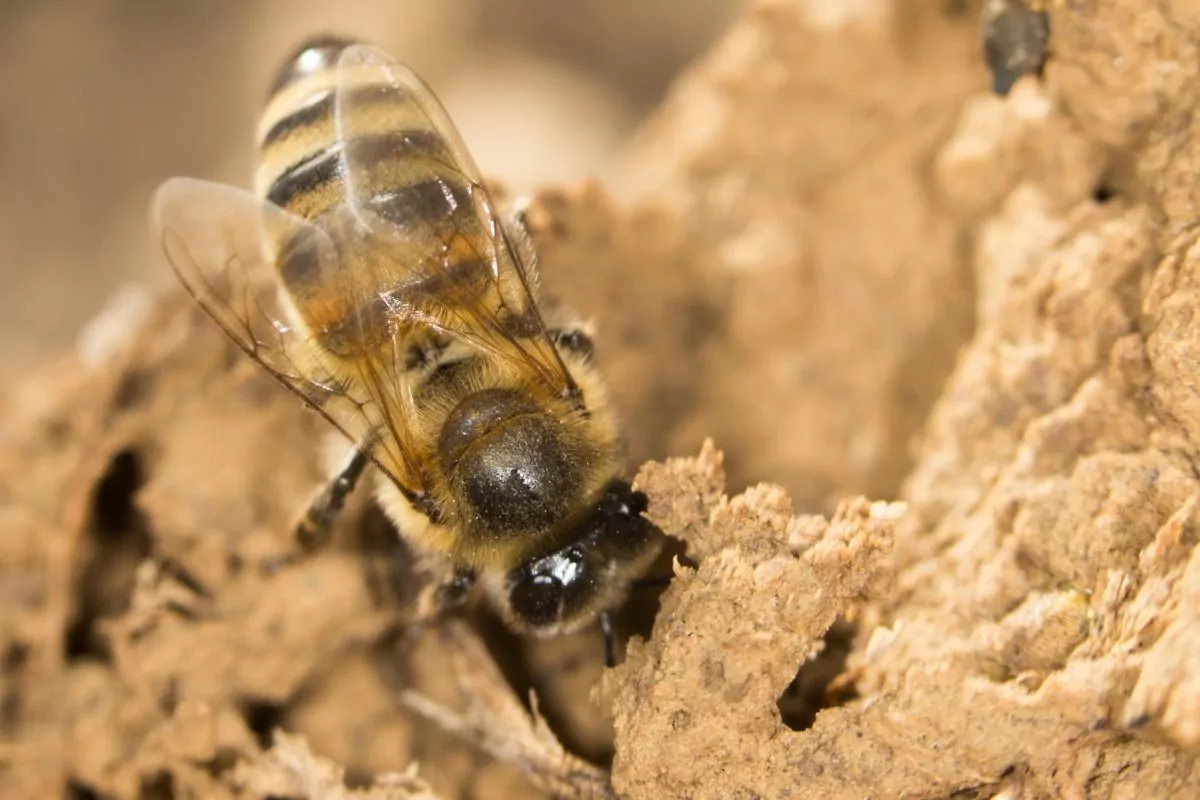Having happily buzzed around your flowers and investigated your plants, the bee will often retreat to its home. For many bees, this means heading underground.

The ground-nesting bee is a common sight in North America.
Ground-nesting bees are solitary, but they’ll often form their homes close together. You might notice a quiet corner of your yard seems to attract a lot of bee activity.
If the soil is the right consistency, this could be where the bees are creating a home.
In this guide, we’ll take a look at the most common types of ground bees, and what to do if you have ground bees in your yard.
What Bees Live In The Ground?
A lot of bees prefer to make their nests in the ground! Roughly 70% of all bees around the world choose to live (see also: How Long Do Bees Live?)in underground nests, which is where they’ll lay their eggs.
These bees are solitary bees, and they don’t live in colonies.
However, despite what the name might suggest, they don’t live completely alone. Many ground-nesting bees like to set up their homes close to other members of their species.
It isn’t unusual to come across bee nests in the ground of your yard, but it can be unexpected. You might worry that low-flying bees could pose a risk to your safety as you move around the yard.
A bee’s ground nest can be identified by a small mound of soil with a slight opening.
There are likely to be a few nests close together, and depending on the species, you could find quite a few bees gathering in one place.
Nesting bees are no cause for alarm. In fact, they can be beneficial to your yard! To better understand ground-nesting bees, check out this guide to some of the most common types.
Bumblebees
The round and fluffy body of the bumblebee is often the first image that comes to mind when we picture a bee.
Although we tend to picture bumblebees buzzing around the planting, most types of bumblebees like to make their homes underground.
Bumblebees are opportunistic nesters, preferring to make homes in convenient places, rather than build their own nests.
Old mice burrows and rabbit burrows are both popular nesting sites for bumblebees, but any dry space will do.
Bumblebees line their nests with wax and pollen, and a queen will live in her nest as she hatches her eggs and tends to her young.
Not all species of bumblebees like to live underground, with some preferring to nest in trees, or even in thick grass.
Miner Bees
It’s no surprise that a bee with the name “miner” likes to head underground. These bees are also sometimes referred to as “digger bees”, so it’s easy to see where they make their homes!
These are solitary bees, although they do tend to build their nests close together.
The miner bee can often be mistaken for the bumblebee. They’re small, furry, and appear in the summer. The miner bee likes dry soil with good drainage.
They’re often found in warm, desert climates. If a miner bee finds a home it likes, it can stay in the same nest for several years!
Sweat Bees
Sweat bees get their name from their habit of being drawn by perspiration.
There are several types of sweat bees with varying appearances. Some sweat bees are metallic, some have yellow patches, but most sweat bees are dark in color.
Sweat bees like to make their nests in the ground, often in damp soil. A sweat bee might build a nest near a river bank, or a place with clay soil.
The sweat bee will create a waterproof cell, where an egg is laid. To help a sweat bee find its home, individuals often line the tunnel with scented secretions.
And More!
These are some of the more common ground-nesting bees you can expect to find in your yard in the U.S.
Other types of bees such as alkali bees, leaf cutter bees, and carpenter bees can all make their homes underground.
Do Ground-Nesting Bees Sting?
Ground-nesting bees can sting, but for the most part, they’re gentle and non-aggressive. A ground-nesting bee is only likely to sting if it feels you present a danger.
Do You Need To Get Rid Of Ground Bees?

It can be a little alarming to discover a group of bees has decided to call your yard home, but there’s rarely anything to worry about.
Ground-nesting bees are typically docile, and they’re only likely to sting if they think you pose a threat. You don’t need to get rid of ground bees, (see also: How To Get Rid Of Ground Bees)just give them space to do what they need.
In fact, having ground bees can actually be beneficial. They act as pollinators, helping your planting to thrive.
If you do want to get rid of ground-nesting bees, there’s an easy way to do it. Simply fill a spray bottle with part water and part vinegar. Spray the solution around the nesting area.
The bad smell and excess moisture can deter the bees from making a home in your yard.
How Do You Tell The Difference Between Yellow Jackets And Ground-Nesting Bees?
Yellow jackets also like to make their homes underground, but they aren’t as docile as ground-nesting bees. In fact, a yellow jacket can be quite aggressive, especially around food and drink.
Yellow jackets form larger nests than bees, and the entry area is likely to be busy with activity. Yellow jackets also have smooth bodies, with plenty of black and yellow stripes.
As they can be aggressive, we recommend contacting a professional pest removal surface to clear your garden of yellow jackets. Do not spray the ground with water to encourage them to move on.
This can cause the yellow jackets to become aggressive, and they might try to sting you.
Final Thoughts
We tend to think of bees as zipping through the air, but most bee species actually prefer to make their home underground. Ground-nesting bees are largely docile, and can be beneficial for your yard.
If you do want the bees to move on, a simple vinegar and water spray can convince them to nest elsewhere.
- Do Bug Zappers Kill Bees? Completely Explained - April 9, 2024
- Does Brake Cleaner Kill Bees? Full Explanation - March 20, 2024
- Do Bald-Faced Hornets Kill Honey Bees? & How to Protect Them - March 4, 2024
